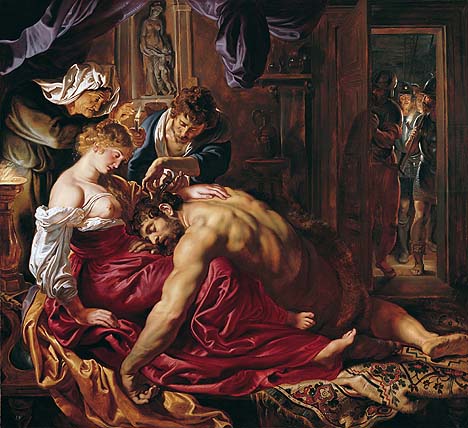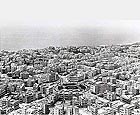
translated and summarized by: Liz Wollner-Grandville,
English summary March 10 - 17
Städtische Galerie im Lenbachhaus: Rupprecht Geiger - Retrospective
Object: Colour
On the occasion of Rupprecht Geiger’s 100th birthday the Städtische Galerie im Lenbachhaus in Munich is showing a retrospective of his work ranging over the past 7 decades. The painter and architect, who still works in his studio every day, became famous for his intensive red-colour art and is one of Germany’s most impressive artists.
Geiger, whose father was suspended from work as an art professor by the Nazis, grew up in the liberal and “wild 20’s” in Munich. He became acquainted with the most important art trends of his time at an early age. During the 40’s he worked as a wartime artist in the Soviet Union and Greece. The aquarelles with their high horizons and special lighting are forerunners of his later experiments with colour. Towards the end of the 40’s he starts to create “shaped canvases”. His simultaneous development with that of the US art scene is remarkable. In 1948 Clement Greenberg publishes his prophetic article “The Crisis of the Easel Picture”, which is a farewell to the classic panel painting and postulates the “all over” of colouring.
Even if Geiger never read this article, this is exactly the way he conceived his newly acquired artistic freedom. In 1949 Geiger founded the Group ZEN 49, which was committed to abstract art and the tradition of the “Blue Rider”. In the late 60’s oval shapes shaded in red, yellow and orange dominate Geiger’s paintings. Later Geiger sprayed a mixture of acrylic and lacquer onto his works, which added a sense of aggressiveness to their beauty. The exhibit at the Lenbachhaus in Munich offers a comprehensive overview of the consequent development of Geiger’s style and can easily be seen in reference with the current Rothko-retrospective in Munich.
Städtische Galerie im Lenbachhaus
80333 München, Luisenstrasse 33, until 30.03.08
www.lenbachhaus.de
Liechtenstein Museum: Samson and Delilah. A Rubens-painting has returned
Brief comeback of a Rubens painting
“Samson and Delilah. A Rubens-painting has returned” - one could assume that Johann Kräftner, Director of the Liechtenstein Museum might have purchased a new painting. But the exhibit is an inventive project, which was assembled to commemorate the 30th anniversary of the Rockox House Museum in Antwerp to which the Liechtenstein Museum linked up with a special reference.
The title of the exhibit becomes much clearer in the context of the painting’s history: Peter Paul Rubens created “Samson and Delilah” as a mantelpiece painting after his return from Italy in 1610 for his friend and sponsor, the mayor of Antwerp, Nicolaas Rockox the Younger. At that time mantelpiece paintings were most fashionable in Antwerp. In his piece of art Rubens not only included some typical Italian features, but also references to his client. After Rockox’ death the painting changed hands frequently until it was in the possession of the Liechtenstein family between 1700 and 1880. The painting decorated the walls of both Liechtenstein Palais in Vienna. “Samson and Delilah” is therefore currently on a brief return to Vienna before it will go back to the National Gallery in London - its current owner.
There is an additional feature connected to the painting, which makes this exhibit even more exciting or as Kräftner puts it: “an exhibit, which deals with one painting, but shows so much more”. The Pinakotek in Munich possesses the “Banquet in the house of Mayor Rockox” (1630 - 1635) painted by Franz II Francken, created two decades after “Samson and Delilah”. The Liechtenstein is currently displaying the highlights of the Rockox Collection, and the Rubens-painting is positioned in the centre over the mantelpiece. It is known that the works were distributed among at least three floors of the Palais. The exhibit can therefore be seen as a reflection of the former status as well as Rockox’s high standard of education.
Liechtenstein Museum
1090 Vienna, Fürstengasse 1, until 25.05.08
www.liechtensteinmuseum.at
Kunsthalle der Hypo Kulturstiftung: Mark Rothko - Retrospective
Stunningly deep and elevated
Maybe the 23rd September 1810 should be considered as the founding day of art reviews. This is the date on which the art exhibit in Berlin opened its gates and among others Caspar David Friedrich’s “Monk by the Sea” was shown. Heinrich von Kleist, editor of the newspaper “Abendblätter” requested a write-up about this painting by one of his journalists, Clemens Brentano. But Brentano wrote the article in sharp contrast to Kleist’s understanding of the painting. While his version was witty, brute, and recognized nothing but superficiality in Friedrich’s painting, Kleist edited the article entirely and created the later famous phrase, that the painting induces a feeling “as if one’s eyelids have been cut away”.
Here they are - the two potentialities of modern art. Does a painting constitute a plane, is it extensive, or is it simply paint covering a background? Or is it transcendence, apprehension, an excerpt from the continuum of infinity? Is it to be considered literal or is it enigmatic?
Robert Rosenblum once said: “In the ‘Monk by the Sea’ - remove the monk and you will get a Rothko” - not to say all Rothkos in a kind of artistic union. Accordingly one could add that the notorious question of “either / or” regarding a plane versus depth is also Rothko’s understanding. Rothko’s understanding and even more so that of his audience. It is all a question of attitude.
The Kunsthalle exhibit offers abundant material to observe one’s own attitude. The show, which was arranged with the support of Rothko’s children, displays the range that emerges if one applies a third monochrome plane to two others. The realistic, classicistic, surrealistic early pieces are not left out, but his signed paintings are the outstanding and unique ones.
Is something shimmering? Is it fog, clouds, the atmosphere? Or is it at least a coloured pad, and is it floating? Or do all these metaphors lead to nothing and the melanges of colours are what they are? It is all a question of attitude. Lets describe it with Brentano’s words, which he overheard in a conversation among visitors to Friedrich’s exhibit: “Man: extremely deep and majestic - Lady: You mean the sea? Yes, it must be stunningly deep. And the Capuchin must be very elevated”.
Kunsthalle der Hypo-Kulturstiftung
80333 Munich, Theatinerstr. 8 until 27.04.08
www.hypo-kunsthalle.de
Architekturzentrum Wien: The White City of Tel Aviv - Tel Aviv’s Modern Movement
Holy New Neu-Friedenau
“How can it be that the same architects who incessantly talk about the ‘country’s requirements’, design buildings in the same style in which buildings had been constructed when they left Breslau or Berlin? Aren’t they aware of the old traditions of architecture in this country? Aren’t they aware of modern designs in the world? Will they continue to make our shopping streets resemble the German town of Pankow and our residential areas look like Neu-Friedenau?”
Tel Aviv not only resembles Great Pankow and a new Neu-Friedenau; it also looks like Little Odessa and Little Warsaw. But Julius Posener’s quoted letter, which he sent to his friend Salman Schocken, who had immigrated to Palestine in 1936, is not entirely correct. After all, Bauhaus architect Arieh Sharon, founder of the architectural association “Chug” and married to Gunta Stölzl, as well as Schocken’s favourite architect Erich Mendelsohn, all moved to Palestine in 1934.
The city of Tel Aviv, whose population increased from 50.000 to 120.000 between 1930 and 1935, is on the UNESCO World Heritage List since 2003 for its outstanding architectural ensemble of the 30’s. The current exhibit at the Architectural Centre in Vienna shows carefully manufactured models, visualisations and plans of individual objects. One can view the architecture with Posener’s critical eyes or as a testimonial of its own era and historical circumstances - both attitudes are rewarding.
Architekturzentrum Wien
1070 Vienna, Museumsquartier, Museumsplatz 1 until 19.05.08
www.azw.at
Mehr Texte von translated and summarized by: Liz Wollner-Grandville


 Teilen
Teilen



